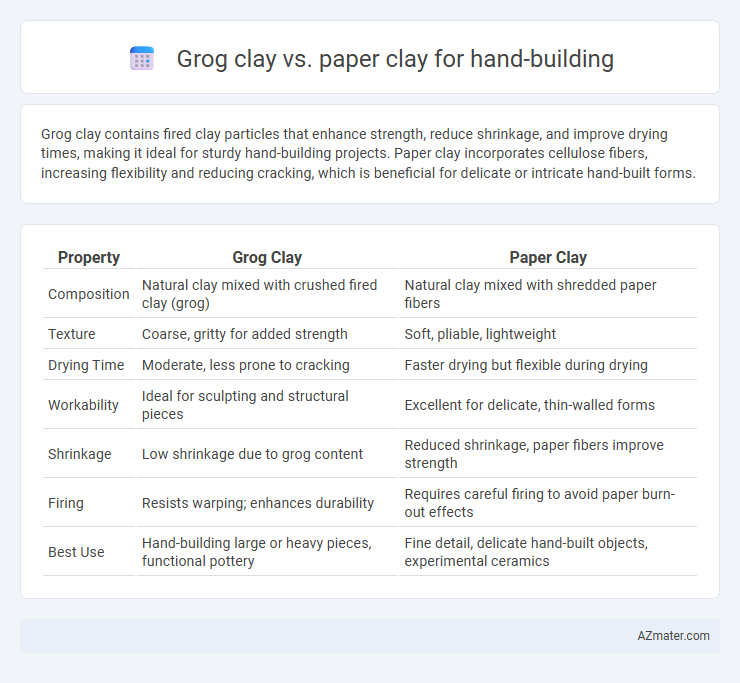Grog clay contains fired clay particles that enhance strength, reduce shrinkage, and improve drying times, making it ideal for sturdy hand-building projects. Paper clay incorporates cellulose fibers, increasing flexibility and reducing cracking, which is beneficial for delicate or intricate hand-built forms.
Table of Comparison
| Property | Grog Clay | Paper Clay |
|---|---|---|
| Composition | Natural clay mixed with crushed fired clay (grog) | Natural clay mixed with shredded paper fibers |
| Texture | Coarse, gritty for added strength | Soft, pliable, lightweight |
| Drying Time | Moderate, less prone to cracking | Faster drying but flexible during drying |
| Workability | Ideal for sculpting and structural pieces | Excellent for delicate, thin-walled forms |
| Shrinkage | Low shrinkage due to grog content | Reduced shrinkage, paper fibers improve strength |
| Firing | Resists warping; enhances durability | Requires careful firing to avoid paper burn-out effects |
| Best Use | Hand-building large or heavy pieces, functional pottery | Fine detail, delicate hand-built objects, experimental ceramics |
Understanding Grog Clay and Paper Clay
Grog clay contains pre-fired clay particles that improve strength, reduce shrinkage, and enhance thermal shock resistance, making it ideal for hand-building robust ceramic pieces. Paper clay incorporates cellulose fibers, increasing tensile strength and flexibility, which allows for thinner walls and easier joining of wet and dry pieces. Understanding the differences between grog and paper clay helps artists choose the right material based on the desired texture, workability, and final durability of their hand-built ceramics.
Composition and Material Differences
Grog clay contains pre-fired clay particles that improve workability, reduce shrinkage, and enhance thermal shock resistance, making it ideal for robust hand-building projects. Paper clay incorporates cellulose fibers from paper, increasing plasticity, allowing for thinner walls and complex shapes while improving drying strength and crack resistance. The primary material difference lies in grog's granular texture versus paper clay's fibrous structure, impacting the clay's drying, firing behavior, and sculptural capabilities.
Workability and Texture Comparison
Grog clay contains pre-fired clay particles that improve workability by reducing shrinkage and increasing structural strength during hand-building, resulting in a gritty, textured surface ideal for sculpting and adding durability. Paper clay incorporates cellulose fibers, enhancing plasticity and flexibility, which allows for extended working times and easier joining of pieces, yielding a smoother texture with less cracking potential. Both clay types enhance hand-building techniques but differ in texture and handling, with grog clay favoring rough, resilient builds and paper clay offering fine, pliable forms.
Strength and Durability Analysis
Grog clay contains pre-fired clay particles that enhance the strength and durability of hand-built pottery by reducing shrinkage and minimizing cracking during drying and firing. Paper clay incorporates processed cellulose fibers which improve tensile strength and flexibility, allowing for thinner, lighter constructions that resist breaking under stress. While grog clay offers superior structural integrity for heavy-duty pieces, paper clay excels in creating delicate, intricate forms with improved crack resistance.
Drying and Shrinkage Rates
Grog clay contains pre-fired particles that reduce overall shrinkage and help control drying rates by allowing moisture to escape more evenly during hand-building, minimizing cracking. Paper clay incorporates cellulose fibers, which absorb water and slow drying, promoting flexibility and reducing warping and cracking risks. Compared to grog clay, paper clay typically exhibits lower shrinkage rates and improved crack resistance during drying, making it ideal for delicate or large-scale hand-built ceramic projects.
Suitability for Different Hand-building Techniques
Grog clay contains pre-fired clay particles that enhance texture and structure, making it ideal for coil building and slab construction due to its strength and resistance to cracking. Paper clay integrates cellulose fibers, providing heightened flexibility and plasticity, which suits intricate pinching and detailed sculpting techniques. Each clay type's unique composition directly influences its performance across hand-building methods, with grog clay favoring structural stability and paper clay excelling in delicate, fine-detail work.
Surface Finish and Detailing Capabilities
Grog clay contains pre-fired clay particles that create a rougher, textured surface ideal for robust hand-building projects with enhanced structural support. Paper clay incorporates cellulose fibers, resulting in a smoother surface finish and superior flexibility for intricate detailing and delicate features. Both clays improve workability, but grog clay excels in durability while paper clay allows finer sculptural refinement.
Firing Temperatures and Results
Grog clay contains pre-fired, crushed ceramic particles that enhance thermal shock resistance and reduce shrinkage during firing, making it ideal for high-temperature firings up to 1300degC and producing durable, textured surfaces. Paper clay integrates cellulose fibers, improving wet and dry strength, allowing for intricate hand-building and repair but typically matures between 1000degC and 1200degC, resulting in a lighter, more porous finish. The choice between grog and paper clay influences firing outcomes, with grog clay preferred for robust, heat-resistant pieces and paper clay favored for delicate, detailed works with lower firing ranges.
Cost and Availability Considerations
Grog clay offers enhanced structural strength and thermal resistance but tends to be more expensive and less widely available than paper clay, which incorporates cellulose fibers to improve flexibility and reduce cracking. Paper clay is often more cost-effective and accessible for hobbyists due to its lightweight nature and ease of drying, making it suitable for intricate hand-building projects. Availability varies regionally, with grog clay typically found in specialized ceramic supply stores, while paper clay is increasingly offered by art retailers and can be homemade using recycled paper pulp.
Choosing the Right Clay for Your Hand-building Projects
Grog clay contains crushed-fired clay particles that enhance durability and reduce shrinkage, making it ideal for larger hand-built sculptures and functional pottery needing strength. Paper clay, strengthened with cellulose fibers, offers excellent flexibility and is less prone to cracking, perfect for delicate or intricate hand-building projects with fine detail. Selecting the right clay depends on project goals--grog clay suits robust, textured pieces, while paper clay favors lightweight, finely detailed creations.

Infographic: Grog clay vs Paper clay for Hand-building
 azmater.com
azmater.com